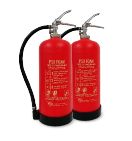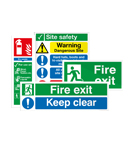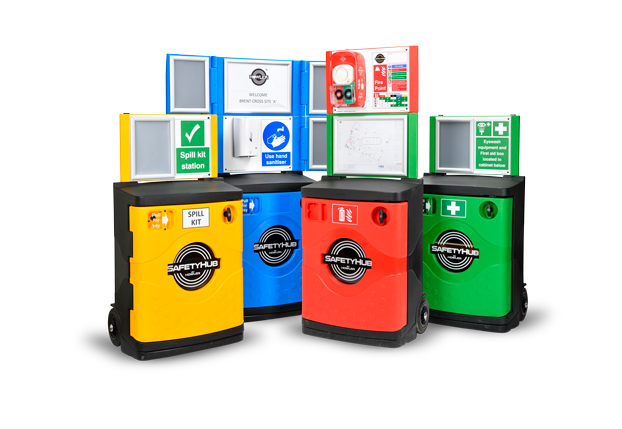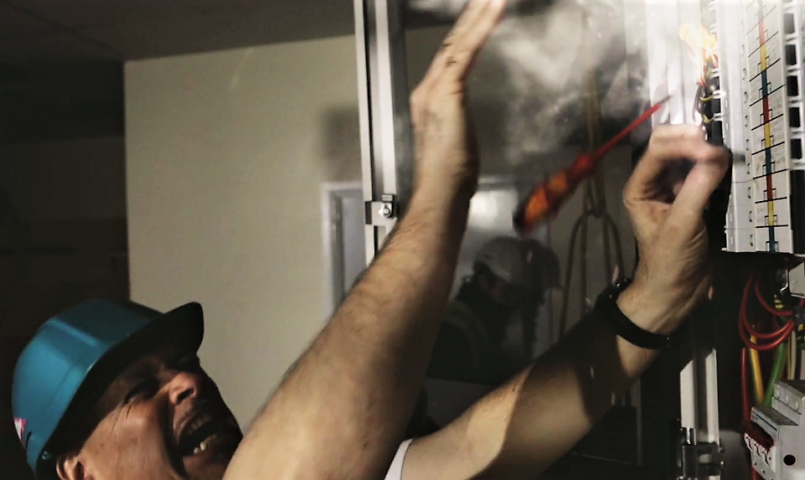In this blog, we go back to basics and review some of the most commonly used Fire Alarm systems for construction sites.
To start with, let’s recap on why a fire alarm system is needed on a construction site. Firstly it’s about life safety – there’s a simple message if there’s a fire; GET OUT! Secondly, it’s there to help protect property; so, the sooner we’re alerted of a fire, the sooner it can be dealt with, minimising damage to the building.
Fire safety standards and fire alarm warning systems
The HSG168 and the JCOP provide clear guidance on fire risks and fire warning systems, summarised as follows:
Fire Safety on Construction Sites (HSG168)
HSG168 is a document published by the HSE aimed at those with a role in developing and managing construction sites, including clients and designers. It is relevant to all construction projects, including small refurbishment sites and explains how everyone involved in construction projects can comply with their legal duties relating to fire risks.
HSG168 states, “The aim of any fire warning system is to ensure that people on the site are alerted to make their escape before a fire becomes life-threatening. The essential requirements of the fire warning signal are that it is distinctive, clearly audible above any other noise and is recognised by all the people on site.”
It further comments, “The sophistication of the method of giving warning of fire will vary from site to site… it is expected on the majority of sites that an inter-connecting (could be wired-in or wireless) system of call points and sounders will be required to provide an effective fire warning system.”
Automatic detection is recommended only on “high-risk sites or in temporary accommodation units (TAUs) such as site offices if there are locations where a fire might occur and develop unnoticed until it threatens people’s means of escape.” ‘High-risk’ sites include timber-frame buildings or those of a largely combustible nature.
Fire Prevention on Construction Sites (Joint Code of Practice)
The Joint Code of Practice (JCOP) is widely recognised and highly regarded. It applies to activities carried out prior to and during the procurement, construction and design process. The objective of the code is the prevention of fires on construction sites.
Most fires can be prevented by designing out risks, taking simple precautions and by adopting safe working practices. The code is concerned with providing a bench03k for fire safety on behalf of insurance companies. In other words, it is interested in protecting property and people.
The JCOP states, “On all sites, a means of giving warning of fire must be established. Certain sites, by their size and nature, may require a temporary hardwired linked system operated from call points.” (Section 8.1).
It also notes that “Electronic alarms are preferable to manual provisions”.
The JCOP is more specific in its requirements for site accommodation blocks, including site placement and interrogating whether their position threatens other buildings in the event of a fire. The JCOP should be read in conjunction with all current legislation and HSG168.
In reference to the aforementioned codes and documents, a fire alarm needs to:
- Be heard by everyone on site
- Be fast and simple to activate
- Be highly visible
- Provide detection where the building is timber-framed
Which fire alarm is suitable for your construction site?
There are many types and models of fire alarms available on the 03ket, and knowing which can support your site the best in the event of a fire is essential.
Some of the best products for construction sites are featured below (product effectiveness is relative to site specifications).
| Description | Most applicable to: | Guide Cost per unit: | Can include detection (for timber-framed buildings)? | |
| Rotary Hand Bell | This basic method of manual alarm system relies on an operator spinning the handle to make a noise – hence the rather apt nickname of ‘Turn & Burn’ alarms. | Nowhere. Seriously – there’s no good reason to use these alarms on a construction site. | £25-£50 | No |
| Air Horn | Similarly, to the rotary hand bell, this method relies on an operator holding down the trigger to maintain the alarm noise – so they are very limited in application. | In some circumstances, it could be used as a basic alert system that is carried by an individual – but is not suitable for full site protection. | £15-£25 | No |
| Battery Operated Standalone Alarms | A ‘hit and run’ alarm that is activated by a single push button and remains on until deactivated but is not linked to other alarms. Introduced as a safer alternative to a manually operated alarm system. | Small ‘open’ sites where the noise of a single alarm can be heard in all areas of the site. | £35-£75 | Yes, but not normally offered as standard |
| Battery Operated Linked Alarms (wired) | A group of battery-operated alarms that are hardwired together to form a system – when any alarm unit is activated the entire system will sound. | Any site where hardwiring the units together is practical and preferred to radio linking (e.g. a high-security location where radio transmission is particularly challenging/not possible). | £50-£75 | Yes, but not normally offered as standard |
| Battery Operated Linked Alarms (Hub & Spoke) | A simple wireless radio linked system where a master unit is positioned centrally and subsidiary units all connect to the master unit. When any alarm unit is activated, the entire system will sound. The system is limited in range, as all units need to ‘talk’ to the master hub unit. | Small to medium-sized sites where the relatively limited signal range constraints are still suitable to cover the entire site area. | £175-£250 | Yes, but not normally offered as standard |
| Battery Operated Linked Alarms (Radio) | The most advanced alarm system is linked together via a radio ‘mesh’ network – meaning the system can cover large areas. The entire system will sound if any alarm unit is activated (or just a selected ‘zone’ depending on the set-up). | All major construction sites. The systems can be designed to suit virtually any application – and are typically where the most recent innovations are available such as continuous fault monitoring, cloud monitoring, and dual first-aid/fire alert systems. Systems generally require installation and maintenance by a trained specialist. | £300-£500 | Yes |
| BS5839 Conventional Fire Alarm system | Conventional fire alarm system as designed for use within permanent installations. | Site accommodation – where within 10 m of either the building under construction or any other permanent buildings. See white paper. | Can vary significantly between projects. | Yes |
Howler UK provides a wide range of top-quality fire alarms that are specifically designed to meet the demands and dangers of construction sites. So no matter the size of your site, we have a solution that will solve your challenges with efficiency and confidence.







